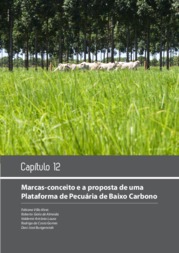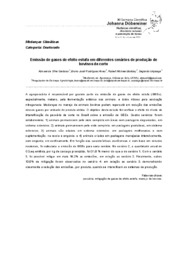Unidade
Embrapa Cerrados
Intensification of BNF as a contribution to the consolidation of Embrapa's Low Carbon Brazilian Beef brand
 Busca de Projetos
Busca de Projetos
Intensification of BNF as a contribution to the consolidation of Embrapa's Low Carbon Brazilian Beef brand

Photo: Nicoline, Humberto
The strengthening of Embrapa's Low Carbon Brazilian Beef brand is the goal of this project, through the consolidation of a process of permanent mitigation of greenhouse gases (GHG) in pastures. The intent is to replace the use of nitrogen fertilizers, whose production entails high GHG emissions, by intercropping pastures with forage legumes that add nitrogen to the system via biological fixation of atmospheric nitrogen. In addition, the presence of legumes increases the pasture's protein supply, allowing greater daily livestock weight gain.
Initially, Embrapa's concept brand was registered for production in well-managed pastures, with the use of nitrogen fertilizers, which increase productivity by transferring to the soil a greater amount of waste that favors carbon sequestration in the soil – or removal of atmospheric carbon dioxide. The accumulation of carbon in the soil is temporary, ceasing after about 20 years. On the other hand, when using pastures intercropped with forage legumes, which provide significant amounts of nitrogen through BNF, it is possible to maintain high levels of productivity along with a permanent mitigation strategy.
For the project's development, intercropped areas will be maintained involving the legumes Arachis pintoi (forage peanut), Desmodium ovalifolium (desmodium) and Macrotyloma axillare (perennial horse gram), present in production systems in the Atlantic rainforest and Amazon regions. In the Cerrado, the pasture areas will be intercropped with Stylosanthes sp. and Cajanus cajan (pigeon pea). For comparison, exclusive pastures of nitrogen-fertilized grass will also be maintained in all biomes.
Animal performance will be monitored, as well as variables related to the forage's quality so that it is possible to quantify the consumption and production of urine and feces by the animals, with their respective nitrogen contents. In addition, nitrous oxide (N2O) and methane (CH4) emissions from excreta and fertilizer, as well as enteric emissions from the animals, will be quantified. Carbon stocks will be monitored to assess the effect of the intercropped plantations.
Finally, the real contribution of BNF will also be investigated through the use of microbial inoculants capable of maximizing the process and ensuring adequate nitrogen entry into the system – BNF is expected to be sufficient to compensate for nitrogen exports by animals and soil losses. In addition, it should be added that another environmental benefit associated with the use of intercropped pastures is that the presence of legumes can favor the transit of native bees and pollinators, in addition to improving soil fertility, due to biodiversity gains.
Initially, Embrapa's concept brand was registered for production in well-managed pastures, with the use of nitrogen fertilizers, which increase productivity by transferring to the soil a greater amount of waste that favors carbon sequestration in the soil – or removal of atmospheric carbon dioxide. The accumulation of carbon in the soil is temporary, ceasing after about 20 years. On the other hand, when using pastures intercropped with forage legumes, which provide significant amounts of nitrogen through BNF, it is possible to maintain high levels of productivity along with a permanent mitigation strategy.
For the project's development, intercropped areas will be maintained involving the legumes Arachis pintoi (forage peanut), Desmodium ovalifolium (desmodium) and Macrotyloma axillare (perennial horse gram), present in production systems in the Atlantic rainforest and Amazon regions. In the Cerrado, the pasture areas will be intercropped with Stylosanthes sp. and Cajanus cajan (pigeon pea). For comparison, exclusive pastures of nitrogen-fertilized grass will also be maintained in all biomes.
Animal performance will be monitored, as well as variables related to the forage's quality so that it is possible to quantify the consumption and production of urine and feces by the animals, with their respective nitrogen contents. In addition, nitrous oxide (N2O) and methane (CH4) emissions from excreta and fertilizer, as well as enteric emissions from the animals, will be quantified. Carbon stocks will be monitored to assess the effect of the intercropped plantations.
Finally, the real contribution of BNF will also be investigated through the use of microbial inoculants capable of maximizing the process and ensuring adequate nitrogen entry into the system – BNF is expected to be sufficient to compensate for nitrogen exports by animals and soil losses. In addition, it should be added that another environmental benefit associated with the use of intercropped pastures is that the presence of legumes can favor the transit of native bees and pollinators, in addition to improving soil fertility, due to biodiversity gains.
Status: In progress Start date: Sun Nov 01 00:00:00 GMT-03:00 2020 Conclusion date: Fri Oct 31 00:00:00 GMT-03:00 2025
Head Unit: Embrapa Agrobiology
Project leader: Bruno Jose Rodrigues Alves
Contact: bruno.alves@embrapa.br


